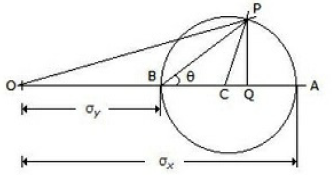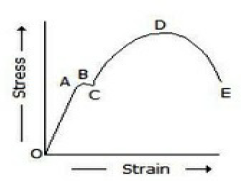The root mean square velocity of the gas molecules is given by (where k = Boltzmann's constant, T = Absolute temperature, and m = Mass of one molecule of a gas)
√(KT/m)
√(2KT/m)
√(3KT/m)
√(5KT/m)
Correct Answer :
C. √(3KT/m)
Related Questions
A process of heating crude oil to a high temperature under a very high pressure to increase the yield of lighter distillates, is known as
Cracking
Carbonisation
Fractional distillation
Full distillation
The variables which control the physical properties of a perfect gas are
Pressure exerted by the gas
Volume occupied by the gas
Temperature of the gas
All of these
The shear force diagram for a simply supported beam carrying a uniformly distributed load of w per unit length, consists of
One right angled triangle
Two right angled triangles
One equilateral triangle
Two equilateral triangles
The deformation of a bar under its own weight compared to the deformation of same body subjected to a direct load equal to weight of the body is
Same
Double
Half
Four times
Impact strength of a material is an index of its
Toughness
Tensile strength
Capability of being cold worked
Hardness
Otto cycle consists of following four processes
Two isothermals and two isentropic
Two isentropic and two constant volumes
Two isentropic, one constant volume and one constant pressure
Two isentropic and two constant pressures
When a rectangular beam is loaded transversely, the maximum compressive stress is developed on the
Top layer
Bottom layer
Neutral axis
Every cross-section
For which material the Poisson's ratio is more than unity
Steel
Copper
Aluminium
None of the above
The neutral axis of the cross-section a beam is that axis at which the bending stress is
Zero
Minimum
Maximum
Infinity
When a closely-coiled helical spring of mean diameter (D) is subjected to an axial load (W), the stiffness of the spring is given by
Cd⁴/D3n
Cd⁴/2D3n
Cd⁴/4D3n
Cd⁴/8D3n
One kg of carbon produces __________ kg of carbon dioxide.
3/7
7/3
11/3
3/11
In a free expansion process,
W1 - 2 = 0
Q1 - 2 = 0
dU = 0
All of these
The efficiency of the Carnot cycle is (where T1 and T2 = Highest and lowest temperature during the cycle)
(T1/T2) - 1
1 - (T1/T2)
1 - (T2/T1)
1 + (T2/T1)
The shear force diagram of a cantilever beam of length l and carrying a uniformly distributed load of w per unit length will be
A right angled triangle
An isosceles triangle
An equilateral triangle
A rectangle
Reversed joule cycle is called
Carnot cycle
Rankine cycle
Brayton cycle
Bell Coleman cycle
In a prismatic member made of two materials so joined that they deform equally under axial stress, the unit stresses in two materials are
Equal
Proportional to their respective moduli of elasticity
Inversely proportional to their moduli of elasticity
Average of the sum of moduli of elasticity
The value of gas constant (R) in S. I. units is
0.287 J/kgK
2.87 J/kgK
28.7 J/kgK
287 J/kgK
In an irreversible process, there is a
Loss of heat
No loss of heat
Gain of heat
No gain of heat
The efficiency of Joule cycle is
Greater than Carnot cycle
Less than Carnot cycle
Equal to Carnot cycle
None of these
The value of shear stress which is induced in the shaft due to the applied couple varies
From maximum at the centre to zero at the circumference
From zero at the centre to maximum at the circumference
From maximum at the centre to minimum at the circumference
From minimum at the centre to maximum at the circumference
High air-fuel ratio in gas turbines
Increases power output
Improves thermal efficiency
Reduces exhaust temperature
Do not damage turbine blades
The heat flows from a cold body to a hot body with the aid of an external source. This statement is given by
Kelvin
Joule
Clausis
Gay-Lussac
Resilience is the
Energy stored in a body when strained within elastic limits
Energy stored in a body when strained up to the breaking of the specimen maximum strain
Energy which can be stored in a body
None of the above
The maximum shear stress, in the given figure, is equal to __________ of the Mohr's circle.

Radius
Diameter
Circumference
Area
The ratio of molar specific heats for mono-atomic gas is
1
1.4
1.67
1.87
Which of the following is a proper sequence?
Proportional limit, elastic limit, yielding, failure
Elastic limit, proportional limit, yielding, failure
Yielding, proportional limit, elastic limit, failure
None of the above
The amount of heat required to raise the temperature of the unit mass of gas through one degree at constant volume, is called
Specific heat at constant volume
Specific heat at constant pressure
Kilo Joule
None of these
When the gas is heated at constant volume, the heat supplied
Increases the internal energy of the gas and increases the temperature of the gas
Does some external work during expansion
Both (A) and (B)
None of these
All perfect gases change in volume by 1/273th of its original volume at 0°C for every 1°C change in temperature, when the pressure remains constant. This statement is called
Boyle's law
Charles' law
Gay-Lussac law
Joule's law
In the below figure, the plastic range occurs

Before point A
Beyond point A
Between points A and D
Between points D and E
